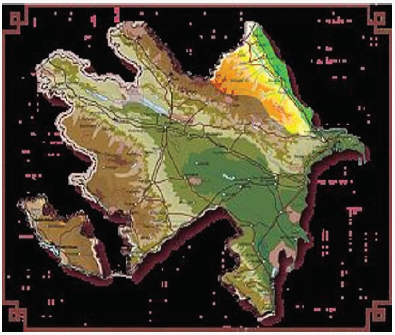
Lupine Publishers Group
Lupine Publishers
Menu
ISSN: 2637-6652
Mini Review (ISSN: 2637-6652) 
Review of The Effect of Climatic Conditions on Development of Erosion Process on Soils of Azerbaijan Volume 2 - Issue 1
RAE Aliyev ZH*
- Institute of Erosion and Irrigation of ANAS, Baku, Azerbaijan
Received: August 30, 2018; Published: September 07, 2018
Corresponding author: RAE Aliyev ZH, Institute of Erosion and Irrigation of ANAS, Baku, Azerbaijan
DOI: 10.32474/MAOPS.2018.02.000129
Abstract
The Researchers proved that the process of soil erosion is also closely linked to climatic conditions of the region. Therefore, depending on the climatic conditions of the erosive processes are different in both forms of its manifestation, and the quantitative indicators of development. For example, in the north-eastern part of the Greater Caucasus Highlands powerful deposition of snow cover, high intensity of spring melting of snow and summer rain dozhdepadov the calling intensive lavages and size of its development areas. But here, against a backdrop of high air temperatures during the growing season, pronounced wind regime and extremely low relative humidity of the air is wind erosion.
Climate also affects the surface configuration. Humid areas where vegetation cover protects the soil from severe manifestations of water and wind erosion, characterized by soft, rounded slopes.
Introduction
Soil erosion is an ongoing process, which consists in moving soil mass from one place to another, under the influence of water, wind and gravity [1] Figure 1. Among the numerous classifications, organize my erosive phenomenon, the most important is the separation of erosion: natural (caused by forces of nature) and accelerated (caused by human activities). Erosion processes caused by forces of nature (wind, water and gravity erosion), the largest scale in a glacial period when the vegetation was negligible.
The emergence of higher (herbaceous and woody) plants, heavily restricted and even helped to overcome the action of erosion processes, accelerate soil formation processes and soil formation [1.3].
Human activities (agriculture (agronomy) erosion) is the main factor which contributes to development and an increase in the intensity of erosion processes, collapsing the Earth’s mainland surface, which led to the significant in terms of size, soil degradation, reducing, and even destruction of its productive capacity, compared with natural conditions [2].
Progress in the Study and Discussion of Materials
(Economic), from the practical point of view - potential erosion, described as erosion risk and actual (current) erosion, described as nephrosion damage in the main dimensions of floating soil masses (in mm of thickness or t / ha or km2). Along with that, in areas with dry climates where the water flows very fast and where the wind taking sand particles and working them as cutter, erases the surface and sweeps weathering products typical of sharply defined overskirt. When examining the erosion problem is extremely important to identify leading factors and establish their relevance to the erosive process. Such determinant nature of erosion is primarily precipitation, then wind regime [3].
Development intensity of erosion processes is defined not only in terms of average annual precipitation in the area, but also to a large extent, their intensity. If the majority of annual precipitation means a weak or moderate rainfall, moisture is absorbed into the soil without runoff and erosion, favorable conditions are created for the absorption of snow cover by shallow drains and erosion of underdevelopment, and if most of the precipitation on the soil of unmeasured or wet enough snow limits its freezing [2, 5]. With little snow cover and the same deep frost heave soil warm spring rains can cause increased melting of snow, strong stock and sharply expressed by erosion. Of equal importance is the distribution of rainfall in time. Especially unfavorable for erosion control is a long, although moderate intense rain and extremely intense [4].
The first type of rainfalls soil sated after some time in the future moisture absorbs it very slowly, with the result that the run-off and surface erosion are amplified When intense. showers water enters the soil surface so fast that even structural, drained soil doesn’t absorb increases it, resulting in the formation of enhanced runoff and erosion. Especially destructive processes of storm-water runoff and flush on doesn’t protected vegetation, slopes, even on soils permeability significantly [2, 3].
Burning drops in this case grind the soil (semi-arid and arid regions), and the aggregates form a ton, diluted mud on the soil surface, which clogs the pores of the infiltration process and sharply reduces the absorption of moisture. This in turn reinforces the excessively drain and erosion even on light soils. There are no washing processes on the surface of the cooled soil. But the freezing and thawing of the soil, taking into account the time, causes the slip of its particles and even flushes down the slope [5].
Especially intensively, these processes of sliding and washing the soils occur in those cases when spring temperatures are accompanied by warm rains. Rains that cause its thawing soil, often wash off its entire surface layer.
The erosion caused by rain and heavy waters, exposure conditions affected to a much lesser extent. Wind is also a very important and active agent of erosion is widely published view portions of wind erosion solely inherent to semi-arid and arid areas, true only to the extent that this factor is most dramatically [3, 5]. In essence, the same uncoated soil surface depends to a greater or lesser degree on the distorting effect of the wind flowing all over the world, and even in the damp regions of the Republic of Azerbaijan [6].
Under the influence of the drilling and sweeping vortex wind movement, small particles of the soil rise into the air, and larger particles are mixed by rolling or jumping, and, settling, form deposits in the form of braids, ridges or barchans, the danger of wind erosion is especially enhanced by dry weather in the spring [2, 6].
References
- Aliev BH, Aliev ZH (2001) Zoning of the territory of Azerbaijan Republic on choosing advanced irrigation techniques. Monograph, Publishing house Ziya, Baku, pp. 297.
- Aliev BH, Aliev, Aliev ZH (2000) Erosion in Azerbaijan and ways of its solution. Ziya-CPI, Naji Baku pp. 122.
- Aliev ZH (2007) The premises about the most important problem of the agriculture in water resource provision mountain and foothill regions of Azerbaijan, JAAS. Baku 1-3: 179-182.
- Central Scientific agricultural library ALL the soil erosion and control (1985) Moscow.
- M Bagrov (1985) Circling-agricultural Reclamation Moscow.
- M Sousse (1989) Soil erosion and control Moscow.

Top Editors
-

Mark E Smith
Bio chemistry
University of Texas Medical Branch, USA -

Lawrence A Presley
Department of Criminal Justice
Liberty University, USA -

Thomas W Miller
Department of Psychiatry
University of Kentucky, USA -

Gjumrakch Aliev
Department of Medicine
Gally International Biomedical Research & Consulting LLC, USA -

Christopher Bryant
Department of Urbanisation and Agricultural
Montreal university, USA -

Robert William Frare
Oral & Maxillofacial Pathology
New York University, USA -

Rudolph Modesto Navari
Gastroenterology and Hepatology
University of Alabama, UK -

Andrew Hague
Department of Medicine
Universities of Bradford, UK -

George Gregory Buttigieg
Maltese College of Obstetrics and Gynaecology, Europe -

Chen-Hsiung Yeh
Oncology
Circulogene Theranostics, England -
.png)
Emilio Bucio-Carrillo
Radiation Chemistry
National University of Mexico, USA -
.jpg)
Casey J Grenier
Analytical Chemistry
Wentworth Institute of Technology, USA -
Hany Atalah
Minimally Invasive Surgery
Mercer University school of Medicine, USA -

Abu-Hussein Muhamad
Pediatric Dentistry
University of Athens , Greece

The annual scholar awards from Lupine Publishers honor a selected number Read More...





